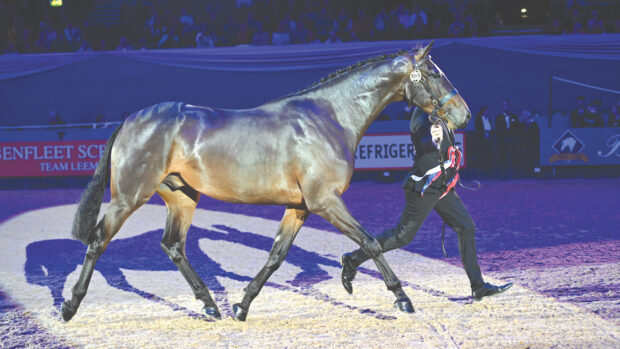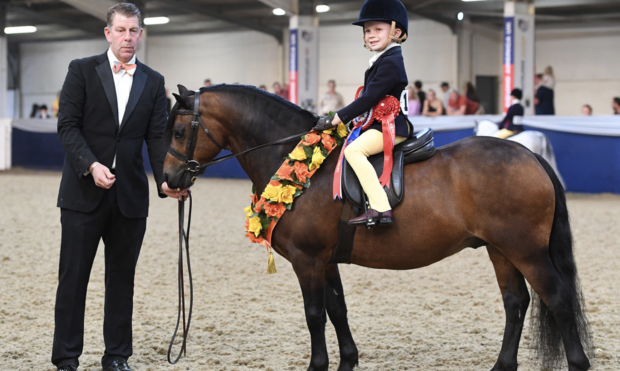If you’re planning to show your non-native coloured — horse or pony — this season, you need to know how to create the best possible picture in the ring.
Know your classes, make an instant impact and avoid common pitfalls with H&H’s guide to non-native coloured classes:
Plaited class options
Coloured horses and ponies are determined by colour and not by breed or type, which means the classes contain a variety of types.
Two societies govern coloured horse classes in the UK:
- Coloured Horse and Pony Society (CHAPS)
- British Piebald and Skewbald Society (BSPA)
You must be a member of CHAPS to contend Horse of the Year Show (HOYS) classes and BSPA to qualify and compete at the Royal International (RIHS).
The non-native ridden classes for coloured show animals are split into two. Ponies must exceed 153cm and include show hunter pony and show pony types. Horses exceed 153cm and are made up of hunters, hacks and riding horses as well as sport types.
What is a coloured?
The definition of a coloured horse or pony is one whose coat colour is either black and white (piebald) or white and any other colour (skewbald) including bay, roan or chestnut; with a patch of naturally occurring white coat.
“This white patch must be on the body above the level of the stifle or elbow, excluding any face markings,” says CHAPS panel judge Robert Parker-Jones. “Any white marking below this does not qualify.”
Manes and tails may also be white or have white in them.
“Broadly speaking a judge would be looking for a show animal,” adds Robert. “If it was a solid colour it would need to fit a particular category. In these classes some judges may have a preference for a stronger type so on the day the hunter type/show hunter pony type may fare better.”
Performance
In horse classes, the performance judge will ride each horse while in pony classes the performance judge will ask each exhibit to perform an individual show either set by the judge or chosen by the rider.
Correct turnout
You must dress yourself and present your horse in line with what its type would be if it were a solid colour; if you are showing your horse as a show hunter, then you dress as you would for hunter classes, and the same applies for riding horse and hack types.
In the pony classes riders on show pony types should wear navy jackets, while show hunter pony jockeys must be in tweed.
The turnout of non-native coloured show animals is also similar to other solid colour plaited classes. If your pony is a show pony type choose a neat coloured browband to enhance and compliment the picture.
Manes should be neatly plaited and tails must be pulled and cut to a length that when carried is approximately five or six inches below the point of the hock.
Quarter marking and sharks teeth may be applied.
Correct way of going
Robert explains what the judges are looking for in the ring:
- “When considering an animals way of going judges have to decide what type the horse or pony is and judge it accordingly. One would expect a hunter type to be more forward going with a longer, free-moving stride.
- “However, in all classes expectations are a free, active walk that covers the ground.
- “The trot must show a freedom of movement from the shoulder.
- “The canter should cover the ground and not be too slow or too collected.
- “When asked to gallop riders should prepare their animals to lower and increase speed gradually.
- “Transitions and rein changes should be smooth and effortless.”
How to make white patches gleam
1. Keep on top of stains
“There are many products on the market that promise the world, but trial and error and word and mouth will guide you. Many swear by using white vinegar, ketchup and Fairy liquid (not all together) on stubborn stains and off white tails, but try it at home first,” suggests Robert.
“I tend to use blue whitening shampoos and always condition manes, tails and feathers,” reveals Liz Wright, who founded the Moortown Stud and has watched two home-bred coloureds’ win at Horse of the Year show (HOYS).
2. Keep animals plaited
“I like to keep manes and tails loosely plaited,” says Liz. “And in some cases, containing them in mane and tail bags can help reduce staining.”
3. Chalk block
“A quick fix on show day is a chalk block which can cover a multitude of sins,” adds Liz.
4. Cover them up
“As much as possible needs covering up following a bath, as unpleasant stains can spoil the picture. Some people bandage their horses but they mainly use hoods and a rug with a neck cover, which helps keep them clean the night before a show,” says Liz.
Riders should
- Find a space so that they can show off their horse or pony at its best.
- When galloping as part of the go-round, find a space and extend and pull up gradually in front of the judge.
- Be polite to judges, stewards and other exhibitors and enjoy yourself.
- Plan your individual performance so that it demonstrates all paces well.
- Ensure several different riders have ridden your horse so that a ride judge will get a good experience riding your horse.
Riders shouldn’t
- Be on animals that are carrying too much condition and are unfit.
- Have too much product applied to horses and ponies and therefore spoiling rather than enhancing them.
- Wear over-tailored jackets that are too short.
- Have too much bling on browbands — and their own clothing.
- Use saddles, stirrup leathers and stirrups that are not big enough for the ride judge.
What are the judges are looking for?
“For judges there is always the issue that exhibits in coloured classes can look very different because the markings are different on each side,” explains Robert. “On the initial go round a favourite can look very different when it changes the rein because the different markings can cause confusion.
“When animals are stripped and stood up for conformation the markings can almost create an optical illusion, for example necks appearing shorter from one side because of the markings. A judge has to see through this to make an informed decision and award an appropriate mark.
“More white or less white are personal choices and if judges were surveyed it is unlikely that a majority would prevail. Therefore potential buyers need to buy what suits them and what they prefer. Less white would certainly mean less preparation time.”
Continued below…

H&H’s guide to show hunter classes: weight categories, presentation and what makes the judges cringe

H&H’s guide to show cob classes: from weight divisions to showing off correctly
How should you present a show cob correctly and how are the different weight categories defined?

Subscribe to Horse & Hound magazine today – and enjoy unlimited website access all year round
Where to compete
All major shows usually include classes for coloured horses and ponies. Normally, the classes will be split (non-native horses, non-native ponies, traditional/native/cob horses and traditional/native ponies).
At smaller shows, there may only be one coloured class, or separate horse and pony coloured classes.
The HOYS CHAPS and the BSPA RIHS classes are of the highest prestige, but there are many opportunities for coloured owners across the board.
The CHAPS and BSPA championships and area shows hold classes for everyone; from first riddens to veterans, from in-hand animals to working hunters.
Horse & Hound magazine, out every Thursday, is packed with all the latest news and reports, as well as interviews, specials, nostalgia, vet and training advice. Find how you can enjoy the magazine delivered to your door every week, plus options to upgrade to access our H&H Plus online service which brings you breaking news as it happens as well as other benefits.




